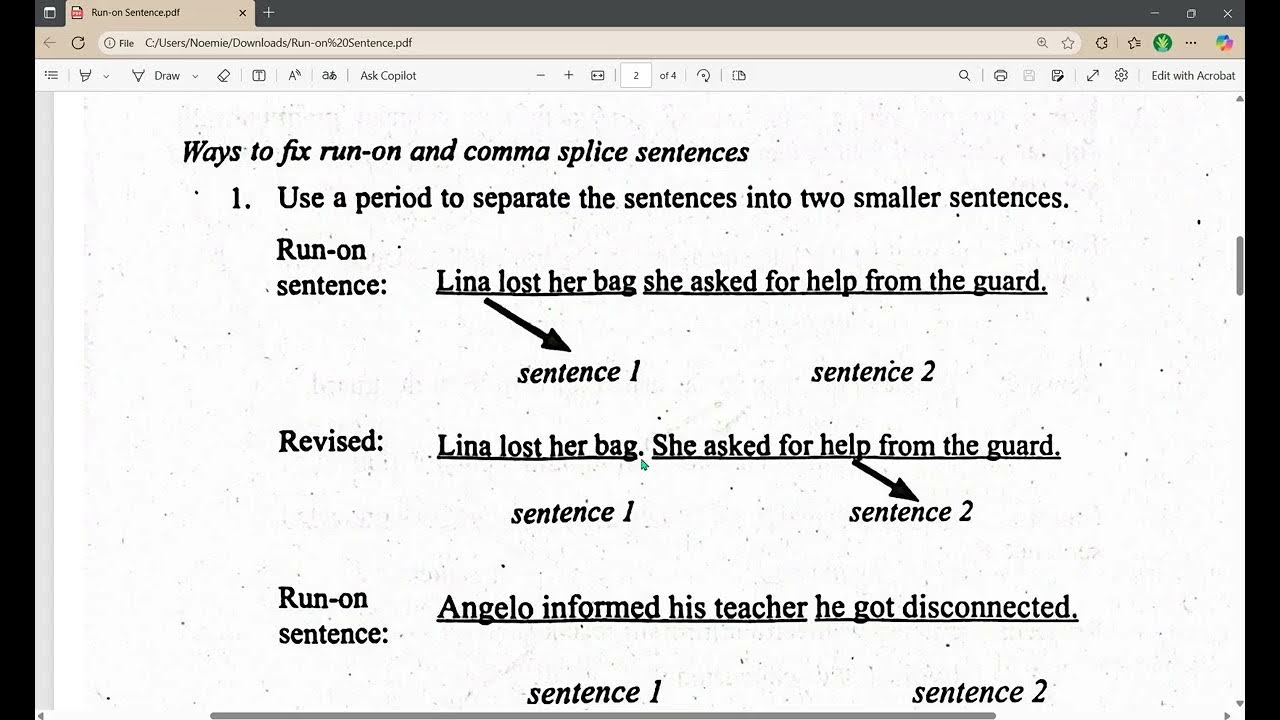konjungsi temporal || Kaidah Kebahasaan dalam TEKS CERITA SEJARAH
Summary
TLDRIn this video, the speaker explains how sentences can become ambiguous without proper conjunctions, using examples like 'I eat, Dad leaves.' The speaker highlights the importance of conjunctions (connecting words) to make sentences clearer, such as by adding 'when' to the sentence, making it 'I eat when Dad leaves.' The speaker goes on to define conjunctions, explaining their types and functions, from connecting words, phrases, clauses, to paragraphs. The video also delves into specific types of conjunctions like additive, causal, temporal, and others, emphasizing their role in sentence structure and clarity.
Takeaways
- 📖 The speaker introduces the concept of ambiguous sentences using examples like 'Saya makan Ayah pergi', highlighting how the meaning becomes unclear.
- 🧠 Ambiguity arises when a sentence has multiple subjects and predicates without clear conjunctions to link them.
- 🔗 The addition of conjunctions like 'ketika' ('when') clarifies the meaning by connecting subjects and predicates properly.
- 📚 Conjunctions (konjungsi) are defined as words that connect parts of a sentence, not meant to explain but to link words, phrases, clauses, or sentences.
- 🛠️ Conjunctions can appear at the beginning, middle, or even after punctuation marks in a sentence or paragraph.
- 📝 The primary function of conjunctions is to connect words with words, phrases with phrases, clauses with clauses, sentences with sentences, and paragraphs with paragraphs.
- 🔍 Conjunctions are categorized based on function, including additive, contrastive, disjunctive, causal, purposive, consequential, comparative, unconditional, explanatory, sequential, affirmative, restrictive, and situational.
- ⏳ Temporal conjunctions are used to describe time-related relationships between events, such as 'when', 'after', 'before', etc.
- ⏩ Temporal conjunctions divide into two groups: those connecting unequal clauses (subordinate) and those connecting equal clauses (coordinate).
- 🛠️ Examples of temporal conjunctions include 'while', 'when', 'after', 'before', and 'until', helping to organize events chronologically.
Q & A
What is the problem with the sentence 'Saya makan Ayah pergi'?
-The sentence 'Saya makan Ayah pergi' is ambiguous and unclear because it contains two subjects ('saya' and 'ayah') and two predicates ('makan' and 'pergi') but lacks a connecting word to clarify the meaning.
How does adding the word 'ketika' change the meaning of the sentence?
-Adding 'ketika' (when) changes the sentence to 'Saya makan ketika Ayah pergi,' making the meaning clearer by showing a temporal relationship between the two actions.
What is a conjunction (konjungsi) as described in the script?
-A conjunction is a word that connects clauses, sentences, or phrases. It does not provide explanation but functions solely as a connector in sentences.
Where can conjunctions be placed in a sentence?
-Conjunctions can be placed at the beginning of a sentence, in the middle of a sentence, or even at the start of a paragraph.
What are some functions of conjunctions?
-Conjunctions connect words with words, phrases with phrases, clauses with clauses, sentences with sentences, and paragraphs with paragraphs.
What are the types of conjunctions based on their function?
-Types of conjunctions include additive conjunctions, contrastive conjunctions, disjunctive (choice) conjunctions, causal conjunctions, purpose conjunctions, consequence conjunctions, comparative conjunctions, conditional conjunctions, explanatory conjunctions, sequential conjunctions, and temporal conjunctions.
What is a temporal conjunction?
-A temporal conjunction links events or actions in terms of time, showing a chronological relationship between them.
Can you provide an example of how a temporal conjunction is used?
-An example of a temporal conjunction is 'sebelum' (before) in the sentence 'Sebelum kelasnya mulai, Pak Guru meminta kami memperkenalkan diri' (Before the class started, the teacher asked us to introduce ourselves).
What is an example of a conjunction used between actions in sequence?
-An example is the sentence 'Bersihkan luka pada kakimu kemudian oleskan obat' (Clean the wound on your leg, then apply medicine), where 'kemudian' (then) is the conjunction indicating sequence.
What is the difference between coordinating and subordinating conjunctions?
-Coordinating conjunctions connect equal parts of a sentence, while subordinating conjunctions connect clauses where one depends on the other, such as 'sebelum' (before) or 'ketika' (when).
Outlines

Esta sección está disponible solo para usuarios con suscripción. Por favor, mejora tu plan para acceder a esta parte.
Mejorar ahoraMindmap

Esta sección está disponible solo para usuarios con suscripción. Por favor, mejora tu plan para acceder a esta parte.
Mejorar ahoraKeywords

Esta sección está disponible solo para usuarios con suscripción. Por favor, mejora tu plan para acceder a esta parte.
Mejorar ahoraHighlights

Esta sección está disponible solo para usuarios con suscripción. Por favor, mejora tu plan para acceder a esta parte.
Mejorar ahoraTranscripts

Esta sección está disponible solo para usuarios con suscripción. Por favor, mejora tu plan para acceder a esta parte.
Mejorar ahoraVer Más Videos Relacionados

Conjunctions for Kids | Learn about coordinating, correlative, and subordinating conjunctions

Run-on Sentence

SHOWING CONTRAST | Materi Bahasa Inggris Lintas Minat Kelas XII | Semester Genap

Cause and Effect Expressions | Because of, Due to .. | Materi Bahasa Inggris Kelas 11

Konjungsi | Bahasa Indonesia | Alternatifa

🟣 CONJUNÇÕES | Aula de Português para concursos, vestibulares, provas, ENEM
5.0 / 5 (0 votes)
